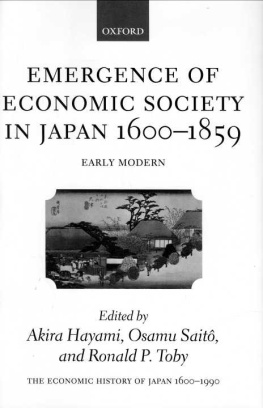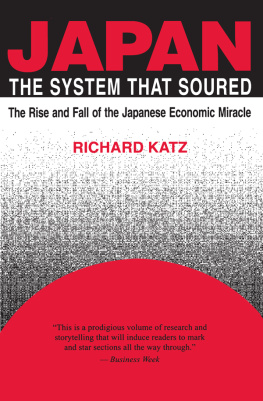

Copyright 2014 Keiko Hirata and Mark Warschauer
All rights reserved. This book may not be reproduced in whole or in part, in any form (beyond that copying permitted by Sections 107 and 108 of the U.S. Copyright Law and except by reviewers for the public press) without written permission from the publishers.
For information about this and other Yale University Press publications, please contact:
U.S. Office:
Europe Office:
Set in Adobe Minion Pro by IDSUK (DataConnection) Ltd
Printed in Great Britain by Gomer Press Ltd, Llandysul, Ceredigion, Wales
Library of Congress Cataloging-in-Publication Data
Hirata, Keiko.
Japan: the paradox of harmony/Keiko Hirata and Mark Warschauer.
pages cm
Includes bibliographical references and index.
ISBN 978-0-300-18607-9 (cloth: alkaline paper)
1. JapanCivilization1945 2. National characteristics, Japanese. 3. Harmony (Philosophy)Social aspectsJapan. 4. Japan-Social conditions1945 5. JapanEconomic Warschauer, Mark. II. Title.
DS822.5.H548 2014
952.04dc23
2014007284
A catalogue record for this book is available from the British Library.
10 9 8 7 6 5 4 3 2 1
For Danny, Mika, and Noah
Contents
Note to the Reader
Japanese names can be written in English in various ways. In this book, we have followed the convention of first name first, family name last (e.g. Shinzo Abe). If only one name is listed, it is typically the last name for authors or public figures (e.g. Abe) and the first name for ordinary citizens used in descriptions of everyday life (e.g. Kenji, the student in chapter 6). In addition, though macrons are often used for long vowels in Japanese words or names, none are used in this book.
When converting yen to dollars, either we use the rate of 100:1, which was the approximate exchange rate in January 2014, or we simply state the amount of yen or dollars listed in the original source without converting. As for weights, Japan uses the metric tonne, equaling 1,000 kilograms (about 2,240 pounds), and that is the term we use throughout the book.
Introduction
After the March 2011 tsunami and earthquake, the world looked on in awe as the Japanese people displayed the resilience and respect they are famed for. With the subway system shut down, millions of commuters walked miles from their offices in Tokyo to homes in the suburbs. There was no reported looting. People stood in lengthy queues to buy food and drinks at convenience stores. Some bought bicycles to get home. Tokyo was packed with scared and exhausted pedestrians walking at a snails pace without shoving, fighting, or arguing.
In the days that followed, the people of Tokyo lined up uncomplainingly for hours in stores to get bottled water or food for their families. Even after they had waited for hours, when items ran out they walked to other stores and waited at the back of the line. There was virtually none of the conflict or chaos that disasters like this often bring to other countries in the world, rich or poor.
Japans collective resolve was even clearer in the coastal areas most affected by the earthquake. The coastal town of Hadenya was devastated, which led to many deaths and casualties.information. The shivering survivors sheltered from the freezing cold in a hilltop community center, amid an apocalyptic landscape of ruined houses and crushed vehicles. With little fuel or food, they immediately organized themselves roughly along the lines of their original community. Those men who had prominent jobs in the community assumed leadership and quickly started assigning tasks. Women boiled water and prepared food, while other men scavenged for firewood and gasoline.
Although they were cut off from the rest of Japan, the Hadenya survivors made contact with five other nearby centers sheltering another 700 refugees. Representatives from the centers met daily to swap supplies and assign tasks.
It took nearly two weeks for the authorities to construct bridges to reach Hadenya. According to the first reporters on the scene, tidy perfectionism ruled the day, with immaculate toilets, cups, and soap neatly lined up, and boxes of supplies stacked in orderly rows. By all accounts, the rapid resumption of order, hierarchy, and a strict division of labor helped Hadenya survive.
Hadenya was not unique. Throughout the Tohoku region, people gathered in schools, community centers, and any other salvageable building. In Rikuzen Takada City, about a thousand evacuees gathered at Daiichi Junior High School. This was one of the largest evacuation centers, and it even appointed its own public relations person to deal with international reporters from CNN, Al Jazeera, and elsewhere. The daily log of the centers activities illustrates the attention to organization. They found an abandoned computer and began logging evacuees 600 on the first day. They built dozens of makeshift toilets out of wood over the course of a week. They formed teams to find and distribute food from local convenience stores, and others to make and serve three meals a day of rice balls and bread. They recruited teams of elementary and junior high-school students to help with babysitting, formed groups that regularly cleaned the makeshift toilets, and held callisthenics sessions set to national radio broadcasts.
Not Losing to the Rain
Such social solidarity is nothing new in Japan. With harsh terrain and little farmland, few natural resources, and more earthquakes and tsunamis than any other place on earth, the people of Japan have always had to come together or perish. Concern for the collective is part of the Japanese cultural DNA. It is encapsulated in one of Japans most famous poems, Not Losing to the Rain, discovered after his death in the suitcase of the famous Japanese poet Kenji Miyazawa, who died at the age of 37 in 1933 in the same Tohoku region that was ravaged by the 2011 earthquake:
not losing to the rain
not losing to the wind
not losing to the snow nor to summers heat
with a strong body
unfettered by desire
never losing temper
cultivating a quiet joy
every day four bowls of brown rice
miso and some vegetables to eat
in everything
count yourself last and put others before you
watching and listening, and understanding
and never forgetting
in the shade of the woods of the pines of the fields
being in a little thatched hut
if there is a sick child to the east
going and nursing over them
if there is a tired mother to the west
going and shouldering her sheaf of rice
if there is someone near death to the south
going and saying theres no need to be afraid
if there is a quarrel or a suit to the north
telling them to leave off with such waste
when theres drought, shedding tears of sympathy
when the summers cold, wandering upset
called a nobody by everyone
without being praised
without being blamed
such a person
I want to become
That remarkable sense of collective resolve has allowed Japan not only to survive, but to thrive. After the Second World War, the nation was devastated. Some 3 million people died in the war seven times as many as in the US, which had twice the population. Millions more were injured, missing, or ill from nuclear radiation. Much of Tokyo and other cities had been leveled by firebombing. The countrys postwar GDP fell to less than $1,500 per capita, well below that of most Latin American countries.
Next page












